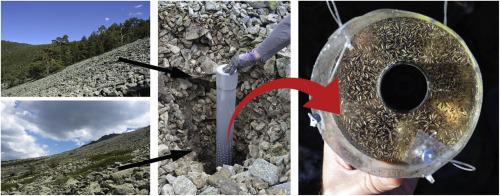Our official English website, www.x-mol.net, welcomes your
feedback! (Note: you will need to create a separate account there.)
Arthropod biodiversity patterns point to the Mesovoid Shallow Substratum (MSS) as a climate refugium
Zoology ( IF 1.6 ) Pub Date : 2020-08-01 , DOI: 10.1016/j.zool.2020.125771 Enrique Ledesma 1 , Alberto Jiménez-Valverde 1 , Enrique Baquero 2 , Rafael Jordana 2 , Alberto de Castro 3 , Vicente M Ortuño 1
Zoology ( IF 1.6 ) Pub Date : 2020-08-01 , DOI: 10.1016/j.zool.2020.125771 Enrique Ledesma 1 , Alberto Jiménez-Valverde 1 , Enrique Baquero 2 , Rafael Jordana 2 , Alberto de Castro 3 , Vicente M Ortuño 1
Affiliation

|
The determinants of biodiversity patterns in the subterranean habitat called Mesovoid Shallow Substratum (MSS) are not well-understood. In this study, thirty-three scree slopes at high altitudes were selected across the Sierra de Guadarrama National Park in central Spain to investigate the effect of ten environmental variables on the abundance and species diversity of the spider and springtail assemblages from the colluvial MSS. In each locality, a multiperforated PVC tube with a pitfall trap inside was buried up to 1 m deep, and generalized linear models and Mantel tests were used to analyze the effect of mainly climate- and habitat-related variables on the diversity patterns of both taxa. A total of 1143 individual spiders belonging to 54 species and 40 811 springtail individuals belonging to 62 species were collected. The analyses indicated that cold temperatures and the presence of forest cover on the surface significantly enhance richness and abundance in the two taxa. Environmental similarity also had a small positive effect on faunistic similarity. However, the effects of temperature and habitat detected on spider richness and abundance were stronger than on springtails, whereas the reverse was found regarding faunistic similarity. These results indicate that subterranean dwellers respond differently to the same environmental factors, which in turn, points to a different degree of affinity for the MSS. The MSS plays an important role in the survival of high mountain arthropod species, acting as a climate refuge, so the protection of this habitat should be prioritized.
中文翻译:

节肢动物生物多样性模式表明中空浅层(MSS)是气候避难所
地下栖息地中生物多样性模式的决定因素称为中空浅层 (MSS) 尚不清楚。在这项研究中,在西班牙中部的瓜达拉马山脉国家公园选择了 33 个高海拔的碎石斜坡,以研究十个环境变量对来自崩积 MSS 的蜘蛛和跳尾虫组合的丰度和物种多样性的影响。在每个地方,一个带有陷阱陷阱的多孔 PVC 管被埋入深达 1 m,并使用广义线性模型和 Mantel 测试来分析主要与气候和栖息地相关的变量对两个类群多样性模式的影响. 共采集蜘蛛54种1143只,跳蛛62种40811只。分析表明,寒冷的温度和地表森林覆盖的存在显着提高了两个分类群的丰富度和丰度。环境相似性对动物学相似性也有很小的积极影响。然而,温度和栖息地对蜘蛛丰富度和丰度的影响强于对跳虫的影响,而在动物学相似性方面则相反。这些结果表明,地下居民对相同的环境因素有不同的反应,这反过来又表明对 MSS 的亲和力程度不同。MSS在高山节肢动物物种的生存中发挥着重要作用,作为气候避难所,因此应优先保护该栖息地。
更新日期:2020-08-01
中文翻译:

节肢动物生物多样性模式表明中空浅层(MSS)是气候避难所
地下栖息地中生物多样性模式的决定因素称为中空浅层 (MSS) 尚不清楚。在这项研究中,在西班牙中部的瓜达拉马山脉国家公园选择了 33 个高海拔的碎石斜坡,以研究十个环境变量对来自崩积 MSS 的蜘蛛和跳尾虫组合的丰度和物种多样性的影响。在每个地方,一个带有陷阱陷阱的多孔 PVC 管被埋入深达 1 m,并使用广义线性模型和 Mantel 测试来分析主要与气候和栖息地相关的变量对两个类群多样性模式的影响. 共采集蜘蛛54种1143只,跳蛛62种40811只。分析表明,寒冷的温度和地表森林覆盖的存在显着提高了两个分类群的丰富度和丰度。环境相似性对动物学相似性也有很小的积极影响。然而,温度和栖息地对蜘蛛丰富度和丰度的影响强于对跳虫的影响,而在动物学相似性方面则相反。这些结果表明,地下居民对相同的环境因素有不同的反应,这反过来又表明对 MSS 的亲和力程度不同。MSS在高山节肢动物物种的生存中发挥着重要作用,作为气候避难所,因此应优先保护该栖息地。











































 京公网安备 11010802027423号
京公网安备 11010802027423号